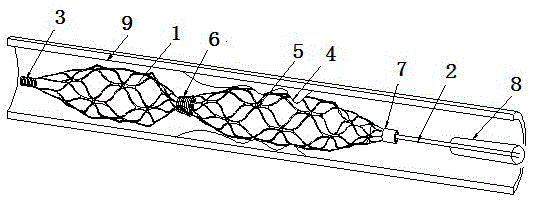Thrombus extraction support device
A stent device and proximal technology, applied in the field of medical devices, can solve the problems of easy thrombus falling off, difficult operation, and large volume of the thrombus-replenishing net, and achieve fast recovery of blood flow, prevention of vasospasm, and high capture performance. Effect
- Summary
- Abstract
- Description
- Claims
- Application Information
AI Technical Summary
Problems solved by technology
Method used
Image
Examples
Embodiment Construction
[0021] Below in conjunction with accompanying drawing, the present invention is further described:
[0022] As shown in the drawings, a thrombectomy bracket device includes a thrombectomy bracket, a delivery guide wire 2, a guide wire 3 and a marking ring, the proximal thrombectomy bracket 5 and the distal protection bracket 1 are sealed at both ends. The mesh structure is characterized in that the thrombectomy bracket is composed of a proximal thrombectomy bracket 5 and a distal protection bracket 1, and the marker ring includes a middle segment marker ring 6, a proximal marker ring 7 and a distal marker. The proximal end of the distal protection bracket 1 is fixedly connected to the distal end of the proximal thrombectomy bracket 5 through the mid-section marking ring 6, and the distal end is fixedly connected to the distal marking and guide wire 3. The guide wire can guide and reduce the delivery of the bracket During the process, the compression of the microcatheter and th...
PUM
 Login to View More
Login to View More Abstract
Description
Claims
Application Information
 Login to View More
Login to View More - R&D
- Intellectual Property
- Life Sciences
- Materials
- Tech Scout
- Unparalleled Data Quality
- Higher Quality Content
- 60% Fewer Hallucinations
Browse by: Latest US Patents, China's latest patents, Technical Efficacy Thesaurus, Application Domain, Technology Topic, Popular Technical Reports.
© 2025 PatSnap. All rights reserved.Legal|Privacy policy|Modern Slavery Act Transparency Statement|Sitemap|About US| Contact US: help@patsnap.com



